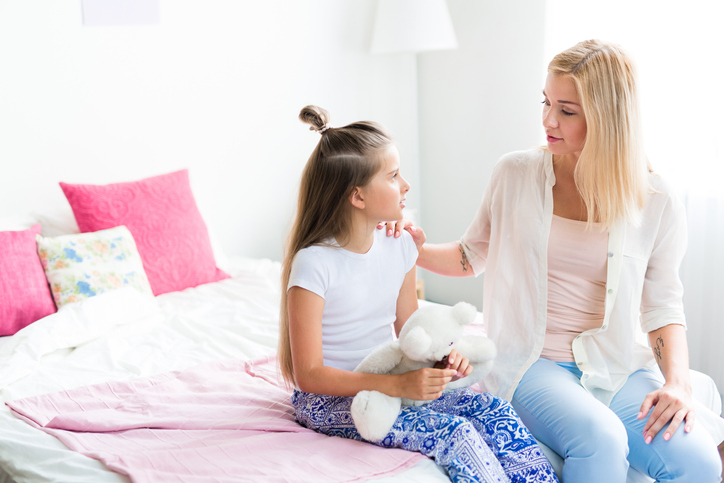Does it seem like every time you go online or turn on your television you see another news story about some disturbing event? Bad news equals good ratings.
In today’s culture of sensationalist media, natural disasters, mass shootings, and terrorism are posted directly to your feed at an alarming pace.
It’s enough to overwhelm adults sometimes, so just imagine the effect this barrage of scary news can have on your kids.
That’s why we’re sharing these helpful strategies for explaining scary news to kids.
Effects of Media On Children
Seeing coverage of upsetting events may cause children to worry that something similar can happen to them or their family.
They can experience a range of emotions, from fear and anxiety, to anger or even guilt.
Scary news can also make kids afraid of things like storms, that never bothered them before. Or it can cause some children to view the world as a threatening and unsafe place.
For all these reasons, when parents find themselves in the position of explaining scary news to kids they need to do it in a way that both informs and reassures them.
A good place to start is by considering your own reactions to disturbing stories. Your kids will look at how you handle the news to form their own approach.
If you stay calm, they will likely follow your lead.
When talking about these tough issues your tone and delivery matter! So keep that in mind.
If your kids see or hear about an upsetting event, the worst thing you can do is try to ignore it and hope it goes away.
Children have trouble fully understanding news stories. Their anxious feelings can last long after the event is over.
As tough as the conversation might be, it’s important to talk it out to help your child cope with their fear.
We’ve put together a list of tips for explaining scary news to kids. Let this be your guide the next time you need to address a dramatic news story.
Tips For Explaining Scary News To Kids
1. Be Age Appropriate
For Kids 7 and Under:
Try to keep them away from the news as much as possible. Kids this age have a hard time understanding or processing difficult events.
Put filters on any devices they might use, and monitor their screen time closely.
If a younger child does hear a scary news story, the name of the game is reassurance. Stress that your family is safe and be there to physically comfort them.
Answer any basic questions, but don’t go into more detail than your child can handle.
For Kids Age 8-12:
You need to really consider your child’s individual maturity level.
Some kids can handle discussions about dramatic events, and some are more sensitive or anxiety prone and can’t.
Tailor their media access to their emotional maturity level.
If they are on the sensitive side or have a lot of anxiety, keep filters in place and monitor what they watch.
If they are more mature, you can start having basic discussions about current events and explain key concepts.
Kids this age get a lot of misinformation from their friends, so check in often to be sure they know fact from fiction.
Teenagers:
Teens likely have access to smartphones or other ways of accessing current news as it happens. Make sure you are open and available for questions.
When a particularly scary news event occurs, don’t wait. Bring the conversation directly to your child.
Teens are able to relate news stories to their own lives and can often be very emotional about events.
Don’t dismiss their feelings! Hear them out.
Also check in to see what source they are using to get their news.
If it’s not a reputable news organization, or you feel the story is exaggerated, let them know and steer them towards a more credible source.
2. Start With Questions
When a news topic comes up, ask open-ended questions to find out what your child already knows like “what did you hear about it?”
This lets you know what your child is thinking, any misinformation they might have picked up, and what their fears are.
They will also likely ask for more details such as: Who died? Can that happen to me? Were they bad people?
By letting your child speak first you can hone in on their specific concerns and address it in a way that reassures your child.
3. Listen And Acknowledge Worries
If a child mentions a scary news incident, like an abduction or hurricane, and says they’re worried it will happen to them acknowledge those feelings. Then offer comfort.
You might say, “I see you’re afraid, but we lock our doors and have a security system to keep you safe at night.”
4. Reassure Them
One of the impacts of media on children is that when a child is exposed to disturbing images or events, they fear for their own safety.
The questions your child asks during your talk can clue you into their specific worries so you can address them.
“That hurricane was far away, we don’t get hurricanes here.” Or, “the people hurt in that accident were taken to the hospital so they can be helped.”
Actions are important to kids, so in addition to talking you may want to show them how they are safe.
Explain your security system, point out where the police officers are, show them your earthquake kit, etc.
These tangible signs of security help them feel more safe.
5. Stick To The Familiar
The unpredictable can be really scary to children. During a difficult event, it helps to surround your kids with friends and family they know and are comfortable with.
Sticking to your normal schedule also helps kids feel safe. If you have a set morning or bedtime routine, keep following it.
This helps kids feel more normal and secure.
6. Keep It Simple
When explaining scary news to kids parents should be prepared to deliver the truth, but only as much truth as their kids can handle.
Keep your answers as simple as possible and tailored to your child’s level of development and understanding.
You don’t need to go into scary detail. A short explanation that makes sense to them and addresses their particular worries is enough.
We’ve put together some talking scripts to help get you started.

Talking Scripts For Explaining Scary News
Pandemic:
Focus on helping your child feel safe, but be truthful. Teach them proper hand washing techniques and other hygiene measure that can help stop the spread of germs.
For Kids 7 and Under:
Kids will likely be worried about getting infected. “can I catch it?”
Speak calmly and reassuringly. Let your child know that you are “taking every precaution to keep that from happening.”
Give your child specific things they can do to feel in control. Teach kids how eating healthy, getting lots of sleep, and proper hand washing can help them stay well.
Explain how hand washing prevents spreading the virus to other people. Then be a good role model and let your kids see you wash your own hands often!
RELATED: How Parents Can Prepare For Coronavirus
For Kids 8 and Older:
Talk about all the things that are happening to keep people safe and healthy. Tell your child that “hospitals and doctors are prepared to treat people who get sick.”
Older kids might also be comforted to know that scientists are working to develop a vaccine.
Put news stories in context. Kids may hear things from the television or people around them. If they’re worried about people dying, explain that “death from infection is very rare.”
Let kids know “it’s okay to feel nervous sometimes. A lot of people are afraid right now.”
But then follow it up by saying, “there are lots of smart people working to find a solution. This will eventually pass and things will go back to normal.”
Natural Disaster:
Generally kids want to know if it can happen to them. A common question is: “Could something like that happen here?”
For Kids 7 and Under:
A simple “we won’t let anything bad happen to you” will generally suffice.
Young kids don’t understand risks or odds, they just want to feel safe. Also emphasize that “this didn’t or won’t happen here”.
We’d leave it at that unless you are in an area that is very prone to a certain type of natural disaster, in which case you may want to expand your answer to remind your child of your family’s basic evacuation plan.
Practicing the plan during safe times will also build confidence.
RELATED: What Do I Need To Know To Prepare For A Natural Disaster?
For Kids 8 and Older:
“I don’t think anything like that will ever happen to us. We have a safety plan for our family here at home and your teachers have one for you at school.”
Older kids may ask more detailed questions about how people in a natural disaster will get help.
You can talk to them about rescue workers and aid organizations like the Red Cross.
Again, instill more confidence by practicing your family’s evacuation plan so your kids know there is a procedure in place.
Older kids can even be assigned a particular job in the plan, like grabbing a first-aid kit kept in their room.
Mass Shooting:
When a tragedy like this happens the question both kids and adults ask is: “Why would somebody do that?”
For Kids 7 and under:
Keeping it simple is best. You can say something like: “His brain was sick” as an explanation.
Little kids don’t fully understand mental illness, but they do understand what being sick means. So a simple answer like this works for them.
Then you want to reassure them that they are safe.
For Kids 8 and Older:
Depending on maturity level you can have a basic discussion about mental illness and it’s effects on people’s actions.
“He had a disease of the brain that caused him to make bad decisions.”
Older kids may also ask more detailed questions, like “what happened to the people who got shot?”
They may feel sorry or worried for anyone that was hurt.
Kids like to feel like there is something they can do to help, so you may want to get them involved in sending donations or well wishes to victim’s families.
Terrorist Act:
If a bombing or other terrorist act occurs, your child may wonder: “Why did they attack that particular place?”
For Kids 7 and Under:
“some bad people wanted to get attention for the things they are mad about and they decided to do a very mean thing.”
Your kids may be confused and tell you that doesn’t make sense.
It’s okay to agree with them! It doesn’t.
This can lead to a helpful discussion about how there are things you can do when you’re mad other than hurting people.
For Kids 8 and Older:
You can explain a little more about prejudice and hate, without being too scary.
“Sometimes people don’t understand each other or agree with each other. There are people who don’t appreciate differences. They are scared or angry about people that are different from them and so they want to hurt them. It’s bad and it’s wrong.”
Then again steer the conversation towards ways people can talk about what bothers them without hurting others.
War or Civil Unrest:
Kids can see images of war torn countries or war victims and wonder: “Why are all those people hurt? What happened to their homes?”
For Kids 7 and Under,
“sometimes different countries don’t agree and they get into a bad fight. But other countries will try to find ways to make it stop so more people don’t get hurt.”
You also want to reassure your child that there are no wars happening in your country so here they are safe.
Remind kids that the best way to solve a problem is by talking and that’s what they should do. Other countries may not know how to do that, but they do.
For Kids 8 and Older:
the same basic explanation above stands, but you might want to expand on it a little.
“Other countries don’t want the fighting to keep going so they may send in soldiers to help stop it.”
If your child asks what the fighting is about, you can give a basic reason for the conflict but don’t make it too difficult: “They are fighting over land,”or “two different religious groups want to run the country”.
Then again, remind them that wars haven’t happened in our country for a very long time, so they are safe here.
After you’ve finished explaining scary news to kids, let your children know they can always come to you if they have more questions.
Then try getting back to your normal family routine as soon as possible.
Predictability breeds security. Your kids’ anxiety will ease when they feel like everything is “back to normal”.
RELATED: Easy Ways To Make Your Home Safer For Your Family
SHARE explaining scary news to kids on Facebook and Pinterest by clicking the buttons below.












